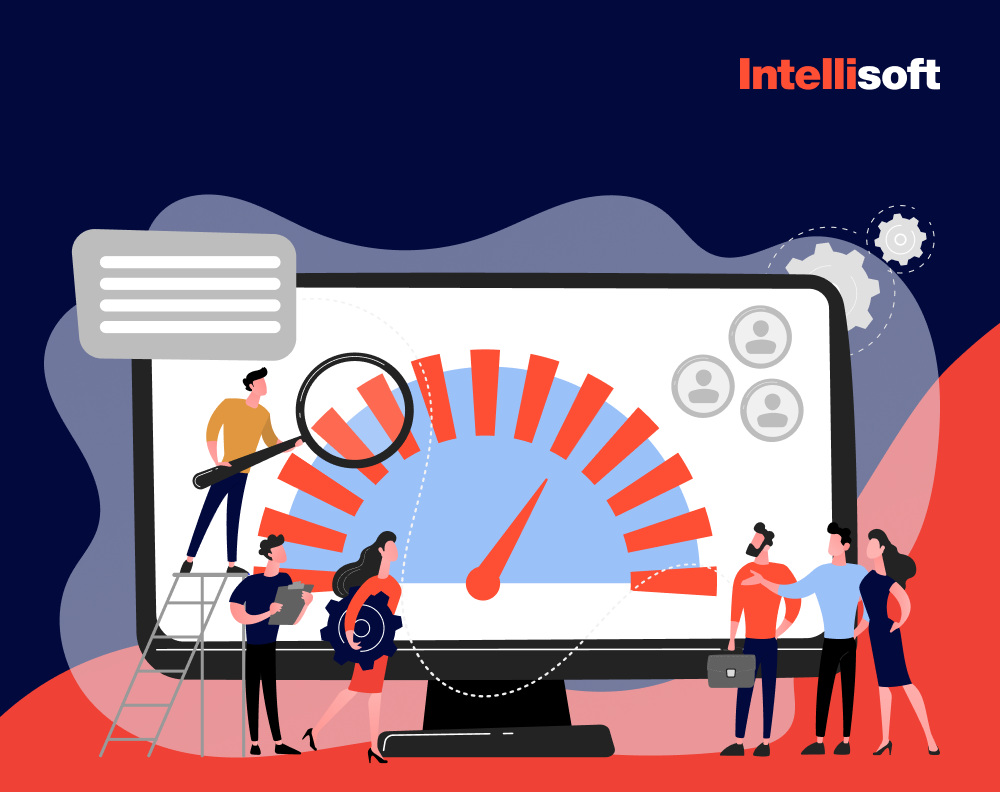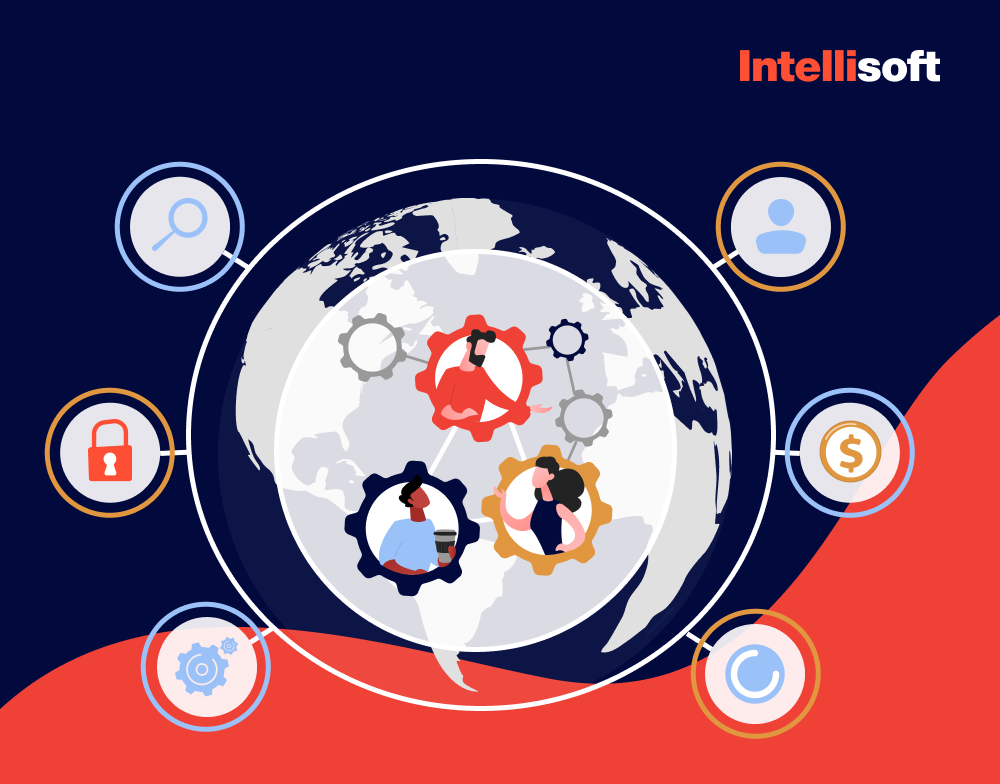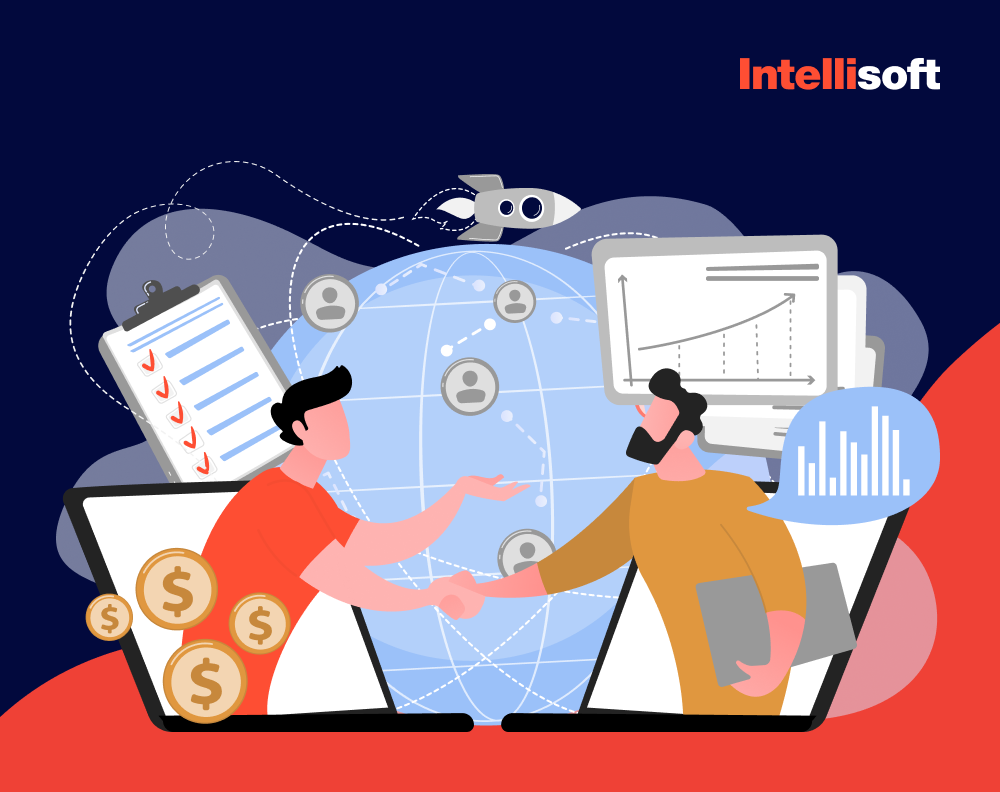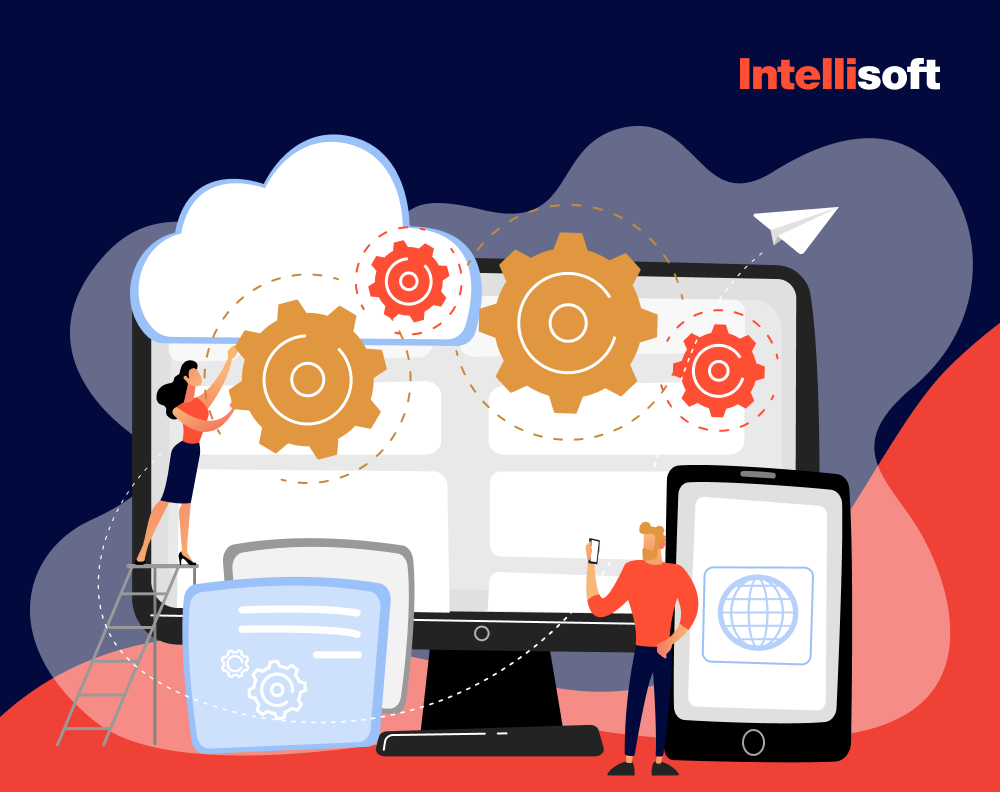Why is IT services outsourcing important for you? In a world where technology changes every moment, the ability to adapt and scale quickly is crucial for your business’s survival and growth. An IT outsourcing services company can relieve you of certain tasks and enhance your core strengths, leading to greater efficiency and cost savings.
The IT world is extremely dynamic, and staying ahead is essential. At IntelliSoft, we excel in providing IT outsourcing services that turn technological challenges into victories. With extensive experience and a keen emphasis on innovation, we deeply understand the IT landscape.
This article explains how IT subcontracting can transform your business operations and why IntelliSoft is the ideal partner for this intricate journey. Whether your goals include reducing costs, tapping into world-class expertise, or speeding up your market presence, we will support you at every step.
Table of Contents
Why Do You Need Outsourcing Services?
Many organizations rely on IT outsourcing, from large enterprises to small startups. This approach helps streamline operations and adds strategic agility to tech projects. But why do such different entities turn to third-party IT specialists? Let’s explore the key reasons IT subcontracting is a crucial business strategy.
Cost Efficiency: A Gateway to Global Talent
One of the strongest arguments for IT outsourcing is its cost-effectiveness. Many outsourcing IT services companies operate in regions with lower economic costs, allowing them to offer skilled expertise at a fraction of the cost compared to higher-salary countries. Outsourcing optimizes your financial resources and gives you access to a global talent pool, ensuring top-quality services without stretching your budget. By outsourcing IT help desk services, companies can significantly enhance their customer support efficiency while reducing operational costs.
Financial Flexibility: Transforming Your Balance Sheet
When you outsource IT functions, these costs become variable rather than fixed. Unlike the salaries of permanent employees, which are fixed expenses, subcontracting costs can be adjusted based on your business needs. This flexibility in financial planning makes outsourcing a smart choice for better managing your company’s balance sheet.
Scalability and Adaptability
Outsourcing IT resources offers unmatched flexibility. Whether you need to scale up your IT capabilities during busy seasons or scale down during slower periods, IT support outsourcing services let you adjust resources without the hassle of hiring or firing. This scalability helps streamline operations and keeps your business agile in response to market demands.
Overcoming Recruitment Challenges
Many organizations struggle to recruit the right tech talent. This challenge could result from a shortage of qualified candidates within budget or a lack of in-house expertise in hiring specialized tech roles. Managed services IT outsourcing companies address this issue by providing access to qualified professionals ready to meet your IT needs, bypassing the lengthy and costly recruitment process.
Broad Applicability Across Various Organizations
IT outsourcing isn’t just for businesses. NGOs, government agencies, sports clubs, and local educational institutions also find it beneficial. The reasons are cost reduction, flexibility, and access to specialized skills. The IT subcontracting landscape is as varied as the organizations it serves. The needs of a local school are very different from those of a startup or a large bank. Additionally, requirements such as compliance with ISO standards, GDPR, or other regulations may necessitate working with larger, more established outsourcing firms.
Understanding which type of IT outsourcing suits your organization is crucial before choosing an IT outsourcing services company. Different types of outsourcing address different needs, and identifying the right one is the first step towards a successful partnership.
What Does IT Outsourcing Mean for Your Business?
In the modern business environment, scalability is a key strategy for survival. As companies aim for growth, expanding their services and market reach becomes essential. Scalability helps businesses boost efficiency, enhance competitiveness, and achieve lasting expansion. But how can you scale up effectively without overstretching your resources or hitting a technological barrier? Enter IT outsourcing.
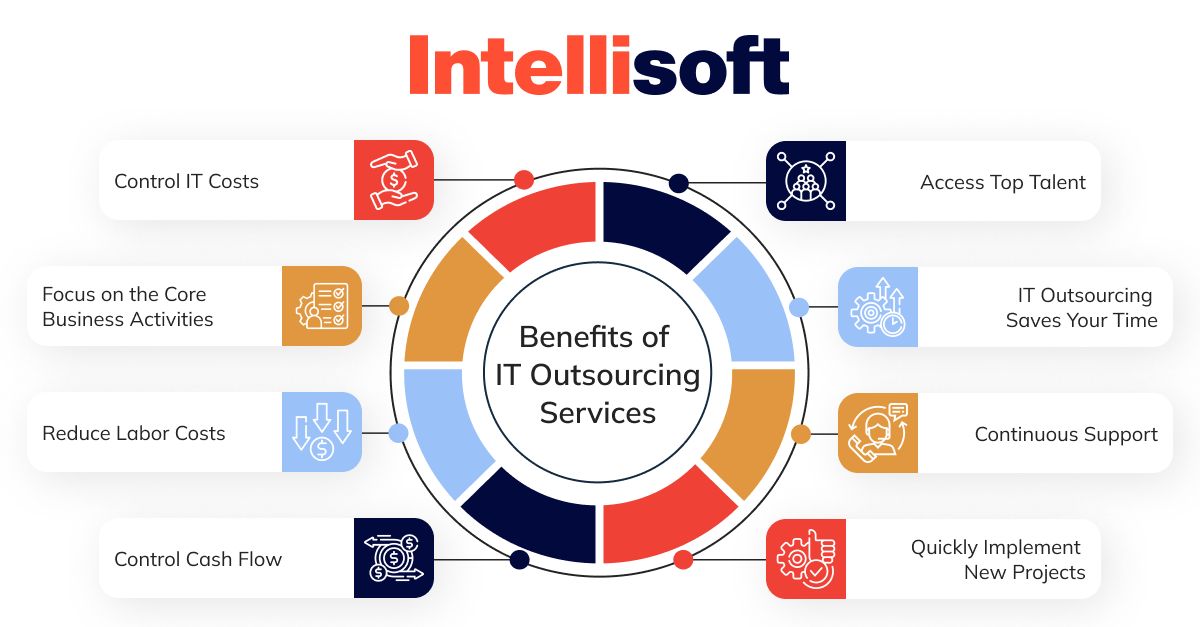
Imagine your business is thriving. Customer demand is soaring, and your market reach is growing globally. You’re on the path to higher profits and a stronger market position. However, with great growth comes greater complexity. The more your business scales, the more complex your IT needs become. No matter how skilled, your in-house team might struggle to keep up with these growing demands.
Technology is the backbone of modern business operations, driving innovation and streamlining processes. Yet, implementing advanced tech solutions isn’t always straightforward. Many companies struggle to deploy new technologies to meet evolving customer expectations and competitive pressures. This is where small business IT outsourcing services excel.
Expertise on Demand
Scaling up often requires specialized software development, data analytics, and cybersecurity expertise. Finding and retaining such skills can be extremely challenging, especially for small and medium-sized enterprises (SMEs). Outsourcing of IT services allows you to access a vast pool of experts without the hassle of recruitment and retention. It’s like having a dream team ready to tackle any tech challenge that comes your way.
Speed is crucial in the race to stay ahead. Your in-house IT team might find it hard to keep up with the rapid pace of technological advancements, which may result in delays in project implementation and slower time to market, costing you valuable opportunities. IT subcontracting companies are built to stay on the cutting edge. They ensure quick deployment of solutions, helping your business remain agile and responsive.
Financial Flexibility
Let’s talk about finances. Building and maintaining an in-house IT infrastructure is expensive. Salaries, training, equipment, and ongoing maintenance can quickly add up, straining your budget. IT infrastructure outsourcing services offer a cost-effective alternative. Turning fixed expenses into variable costs allows you to allocate resources more efficiently and invest in other crucial areas of your business. It’s a smart financial move that boosts your bottom line while providing top-notch outsourcing IT support services.
But IT subcontracting isn’t just about saving money or speeding up processes. It’s about transforming your business. Small business IT outsourcing services give you the flexibility to scale your operations seamlessly, respond to market changes quickly, and innovate without constraints. It lets your internal team focus on what they do best, strategizing and driving growth while leaving the tech heavy lifting to the experts.
IT outsourcing is more than just offloading your tech tasks. It’s a strategic move that enhances your ability to scale, innovate, and compete in a dynamic market. By leveraging the expertise, speed, and cost-effectiveness of subcontracting, you can transform your business operations and position yourself for long-term success.
How Big is the Global IT Outsourcing Market?
The global IT outsourcing market is huge and expanding rapidly. According to GrandViewResearch, the overall IT services market, including in-house and outsourced services, was valued at a massive $870 billion in 2023. By 2030, this market is expected to grow at a compound annual growth rate (CAGR) of 9.5%. IT outsourcing (ITO) is a significant and fast-growing segment within this vast market.
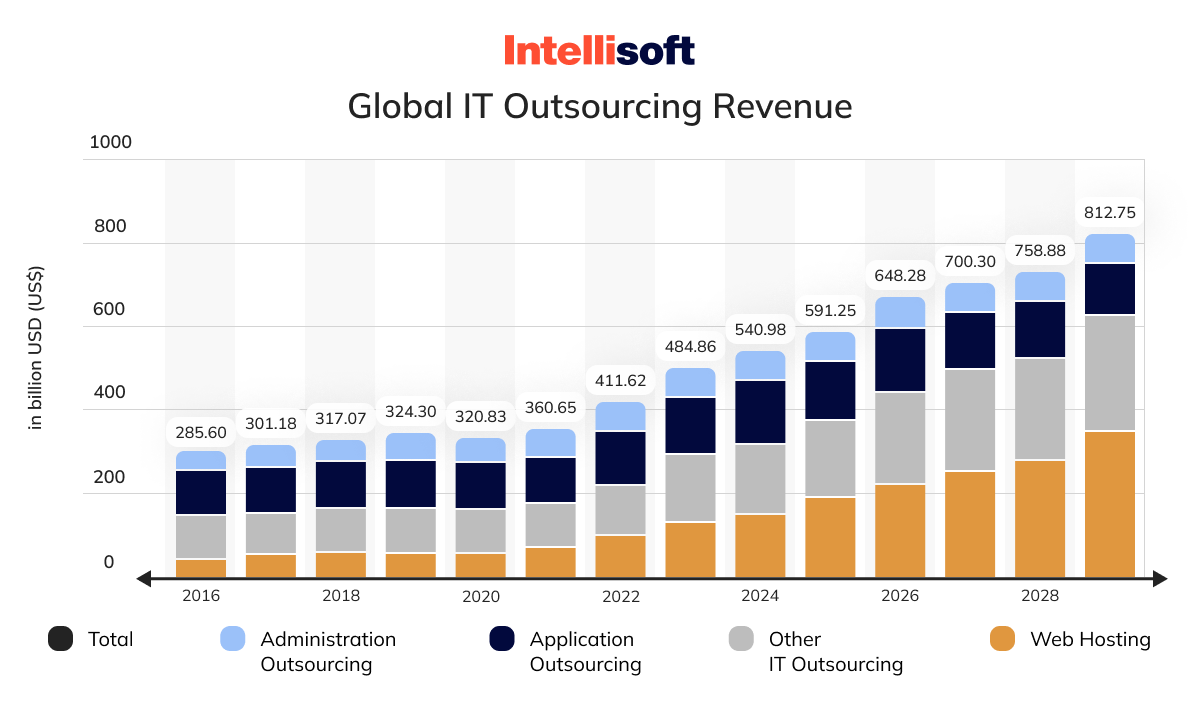
The Dominance of IT Outsourcing
According to Statista, IT outsourcing revenue is projected to reach $541.1 billion in 2024 and is forecasted to grow to $812.7 billion by 2029. This growth represents a compound annual growth rate (CAGR) of 8.48% for the ITO market from 2024 to 2029. The overall IT services market is expected to grow at a CAGR of 6.68% over the same period. These statistics show that IT subcontracting is a large part of the IT services market and one of its fastest-growing segments.
The numbers may differ depending on the statistical research methods used, but the consensus is clear: the IT services and outsourcing market is expanding quickly, and its share of the overall IT services market is growing. This growth is driven by businesses relying on outsourced IT services to improve operational efficiency, access specialized skills, and manage costs effectively.
Is There a Tech Talent Shortage?
The global tech talent shortage is a critical issue impacting the IT outsourcing market. A McKinsey study from 2020 showed that 87% of respondents were already experiencing gaps in their IT teams due to recruitment challenges or expected such gaps soon. By 2023, this situation has only worsened.
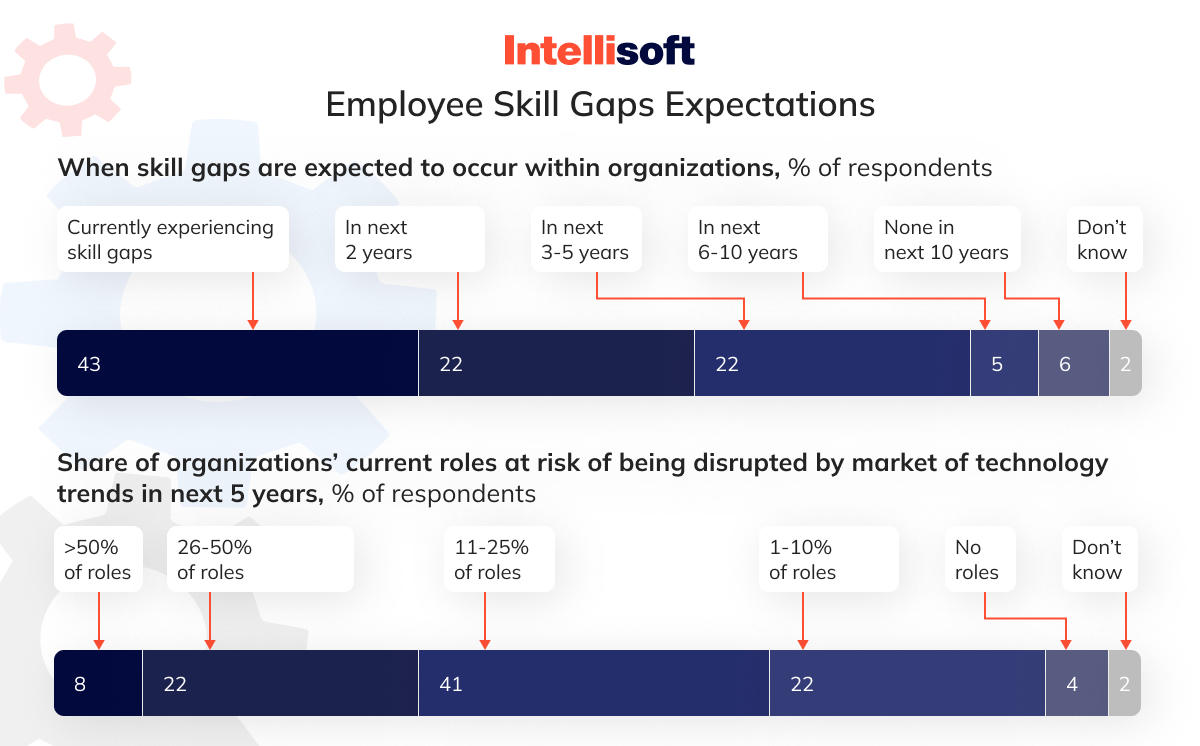
In 2022, 75% of recruiters reported difficulty finding qualified IT candidates. The trend continued into 2023, with a recent Manpower Group report revealing that 4 out of 5 employers worldwide struggle to find suitable staff. Germany, for instance, reported an 86% difficulty rate in finding IT talent, slightly behind Taiwan at 90%.
This shortage is not limited to the IT sector but affects various industries. In the IT sector, the shortage stands at 78%, prompting 55% of employers to consider hiring talent outside their country. This global hunt for skilled IT professionals highlights the critical role of IT outsourcing in filling these talent gaps.
The Implications for Your Business
The growing IT outsourcing market and the ongoing talent shortage present both business challenges and opportunities. On one hand, the shortage of qualified IT professionals can hinder your company’s ability to scale and innovate. On the other hand, the expanding IT subcontracting market offers a viable solution to these challenges.
By outsourcing your IT needs, you gain access to a global talent pool, overcome recruitment bottlenecks, and maintain operational flexibility. Embracing IT outsourcing allows your business to leverage specialized expertise, speed up project timelines, and optimize costs while focusing on core competencies and strategic growth.
Related readings:
- Outsourcing vs. Outstaffing Models: Their Pros & Cons
- Software Development Outsourcing: Building a Winning Dev Team
- Outsourcing Partner Strategies: Achieving Project Scalability and Flexibility
- In-House vs. Outsourcing Software Development Teams
- How Long Does It Take to Find and Hire Outsourcing Team
What Are the Different Types of IT Outsourcing?
Companies have several options regarding IT subcontracting, each aligning with different strategic and operational needs. Understanding these options is important to determining the best fit for your company’s unique requirements. Let’s explore the primary types of IT outsourcing: offshore, nearshore, and onshore.
Offshore IT Outsourcing
Offshore IT outsourcing involves contracting IT services outsourcing companies in distant countries, typically where labor costs are much lower, yet the IT sector is robust and well-developed. This type of outsourcing can lead to significant cost savings and allows for round-the-clock operations due to time zone differences.
For instance, a U.S. company might partner with a service provider in Ukraine or India to provide 24/7 customer support operations without the need for expensive overnight shifts in the U.S. This arrangement not only optimizes operations but also broadens the talent pool, providing access to specialized skills that might be scarce or too costly domestically.
Nearshore IT Outsourcing
Nearshore IT outsourcing means outsourcing IT tasks to countries geographically closer to your own. This closeness offers several benefits, including similar time zones, which aid real-time collaboration and typically fewer cultural differences, simplifying communication. For example, a U.S. company subcontracting software development to Canada or a German company partnering with a Ukrainian provider benefits from overlapping working hours, which enhances day-to-day operations and project management efficiency. Nearshore outsourcing retains some of the cost advantages of outsourcing IT services while adding more convenience for coordination and communication.
Onshore IT Outsourcing
Onshore IT outsourcing refers to contracting services within the same country. This approach eliminates language barriers, cultural mismatches, or significant time zone differences. It supports collaboration and adherence to local regulations, especially for projects requiring frequent onsite interactions or in sectors heavily regulated by local laws. However, onshore outsourcing may not always provide the cost benefits seen with offshore or nearshore options. Moreover, due to talent shortages in many developed markets, finding the right onshore partner can be challenging, potentially leading to higher costs and a limited choice of IT outsourcing services companies.
Each type offers benefits of outsourcing IT services as well as potential drawbacks. Various factors, including your project requirements, budget constraints, desired level of control, communication needs, and strategic business goals, should guide your choice between offshore, nearshore, and onshore.
Outsourcing Models
Selecting the right outsourcing models becomes crucial as your business expands and your IT demands become more complex. These models vary from project-based arrangements to staff augmentation, development centers, and hosting services. Understanding each model’s specifics and best applications can greatly enhance your strategic planning and operational efficiency.
Project-Based Outsourcing
In project-based outsourcing, a company hands over a specific, often complex, project to an external service provider. This approach is perfect for projects that fall outside a company’s core competencies or require specialized knowledge that the internal team lacks. Project-based outsourcing is not limited to short-term tasks – it can encompass a series of projects, enabling ongoing collaboration with the provider. This model allows businesses to scale resources and budgets according to project demands without permanently expanding their workforce.
Staff Augmentation
Staff augmentation is a flexible outsourcing model that enables companies to hire global tech talent and manage this augmented team directly. This strategy is ideal when your in-house team is missing certain skills, or you need additional resources for a project. Staff augmentation fills these gaps with external professionals who integrate into your existing team, bringing specialized skills for the duration of a project or longer-term needs. It is especially useful for companies with variable project demands or those engaged in continuous innovation and maintenance, allowing them to remain agile without the costs associated with permanent hires.
Development Center
Establishing an offshore development center is another subcontracting strategy. This model involves setting up a dedicated facility that operates remotely but is fully integrated with the main office’s functions. Development centers are often located in regions that offer a good mix of talent and cost benefits. They operate as an extension of the home office, focusing on specific IT tasks or projects, and utilize local expertise and resources to enhance operations and cost efficiency.
Hosting
Hosting is a subcontracting model where a company contracts with an IT provider to manage server operations or other infrastructure needs. The provider handles the setup and maintenance of the necessary hardware and software infrastructure. This model is well-suited for businesses needing reliable and secure server management without investing in and maintaining physical infrastructure. It is particularly valuable for small to medium-sized enterprises that require robust IT capabilities without capital expenditures.
These outsourcing models offer unique advantages and can be implemented based on specific business needs, project requirements, and strategic objectives.
What to Look for in an Outsourcing Partner
Selecting the right outsourcing partner is critical for the success of your IT strategy. You must forge a partnership that aligns with your company’s values, objectives, and operational requirements. Here are some crucial qualities to consider when choosing an outsourcing partner to ensure they can support your business needs.
Competence and Specialization
Firstly, the competence of potential IT support and outsourcing services partners should be assessed. Evaluate their expertise in the areas and technologies pertinent to your projects. A dependable way to judge their capability is by examining case studies and portfolios that showcase their experience with similar projects or industries. This due diligence ensures that the vendor has a proven track record of managing tasks like yours with successful outcomes.
Trustworthiness and Integrity
Trust forms the cornerstone of any subcontracting relationship. To evaluate a potential partner’s reliability, consider client testimonials and employee feedback on platforms like Glassdoor. These reviews can offer insights into the company’s operational integrity and client satisfaction. Moreover, check their adherence to industry standards, such as ISO certifications and security training and protocols. These checks ensure your data and projects are managed securely and professionally.
Flexibility and Adaptability
The business environment is ever-changing, and your outsourcing IT support services partner should be capable of adapting to new challenges as they emerge. Flexibility in an outsourcing provider means they can manage unexpected shifts in project scope or deadlines without major disruptions. This adaptability is essential for maintaining continuity in your projects and for integrating new technologies or processes that become relevant to your business.
Scalability
As your business expands, so will your IT requirements. It’s crucial that your outsourcing partner can scale their services to meet your growing needs. You may need to increase the team size, adjust the scope of projects, or enhance technological capabilities. Scalability is critical to any long-term outsourcing relationship, so ensure that your partner has the resources and infrastructure to grow with your company.
Collaborative Compatibility
Often, outsourcing is not about transferring entire operations but rather augmenting and enhancing internal capabilities. Hence, the ability of a subcontracting partner to work effectively with your internal team is paramount. Consider factors like geographical location and time zones, as these can influence the ease of communication and collaboration. A partner operating in a compatible time zone or with effective communication strategies for managing cross-regional projects will be more successful in collaborating with your team.
These attributes are foundational when selecting an outsourcing partner. While these are excellent starting points, further exploration into each area may be necessary depending on your specific needs and the complexities of your projects. For a deeper understanding and additional guidance, you might explore our detailed guides on selecting a software development company and the critical questions to ask when evaluating software outsourcing providers.
How Much Should IT Services Cost?
Determining the cost of outsourcing IT services is a big challenge, given the fluctuating nature of the market and the varying needs of businesses. While it’s difficult to pinpoint a precise figure due to these variables, understanding the fundamental framework for calculating IT outsourcing costs can equip you to make smart financial decisions. Let’s discuss the cost considerations of IT outsourcing and strategies for managing these expenses effectively.
Is IT Project Outsourcing Services Expensive?
The cost of outsourcing IT services can differ greatly depending on several factors, such as the project’s complexity, the service provider’s location, and the required level of expertise. For example, subcontracting application development can result in diverse financial outcomes: around 40% of businesses report higher costs than managing development in-house, whereas 31% find it less expensive, and about 29% see no significant cost difference. These variations underscore the necessity of meticulous planning and selecting the right IT software outsourcing services that align with your budget and business goals.
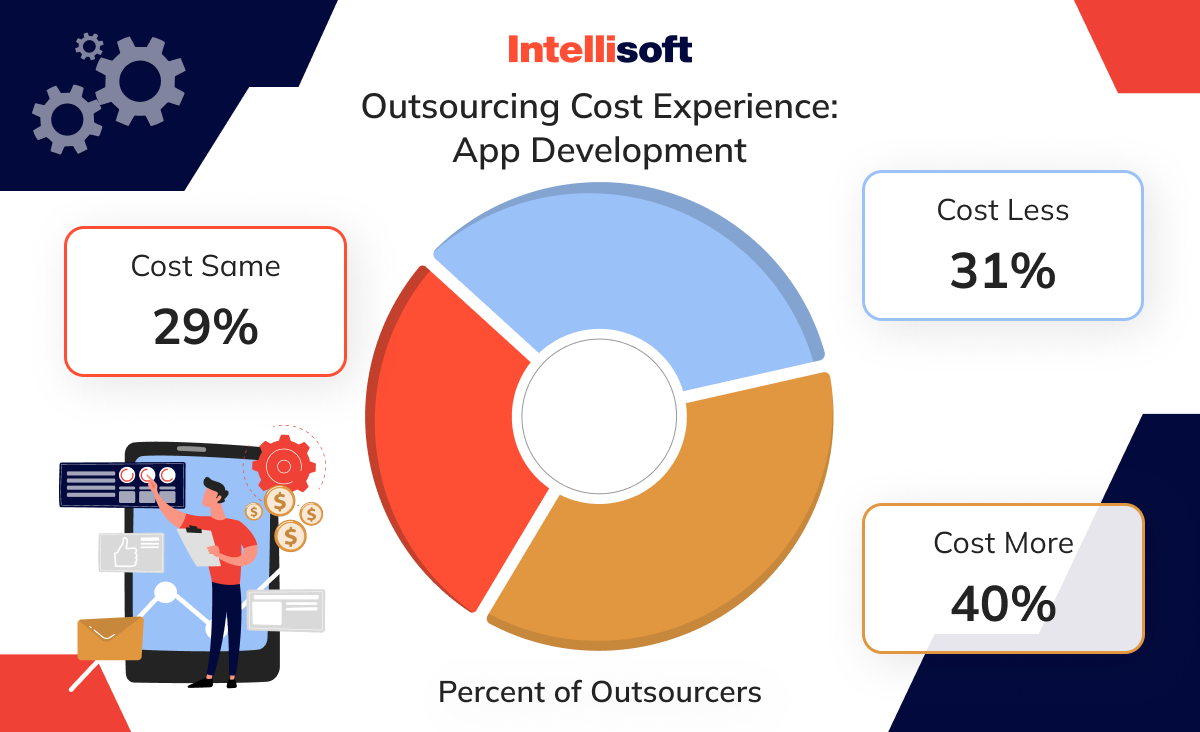
How Does an Outsourced IT Department Reduce Costs?
Outsourcing your IT department can significantly reduce costs in several key areas. For example, you can eliminate the costs of maintaining physical space, utilities, and security for an in-house team. By using IT help desk outsourcing services, you avoid the expenses associated with employee benefits like health insurance, parental leave, and retirement plans. You can reduce the need for additional support staff such as HR, payroll, and legal, which are usually required to manage an in-house team.
Outsourcing eliminates the often expensive processes involved in hiring and retaining skilled personnel, especially in high-demand specialties. By transferring these costs to a third-party provider, companies can redirect their resources towards core operations and strategic investments, potentially reducing overall expenditures while still accessing top-tier IT expertise.
How to Manage Your IT Outsourcing Costs?
Effectively managing IT outsourcing costs involves a strategic approach. Begin by precisely defining your project’s scope and requirements. The clarity helps in accurately estimating costs and prevents scope creep. Select a pricing model that best fits your project’s needs, be it hourly rate, project-based, or milestone-based. Each model offers certain advantages of outsourcing IT services depending on the duration and complexity of the project.
Obtain detailed proposals and cost estimates from various IT outsourcing services companies to understand various options while keeping pricing competitive. Continuous monitoring and management of the project are crucial to ensure that it remains within budget and any unexpected costs are managed promptly. Consider engaging an external consultant or utilizing specialized software to manage and optimize subcontracting expenses. These tools can assist in forecasting costs, comparing provider rates, and managing contracts effectively.
Although IT outsourcing may initially appear costly, when managed properly, it often presents a cost-effective alternative to in-house operations.
Conclusion
Today, we have challenged the misconception that outsourcing is a fallback for handling low-impact tasks. We’ve revealed how IT outsourcing is a pivotal tool for businesses of all sizes, from major tech corporations to emerging startups, offering substantial benefits of IT outsourcing services such as cost efficiency, access to specialized talent, and increased flexibility and scalability.
IT subcontracting cuts costs and enables businesses to concentrate on their core competencies and foster innovation without the complexities of managing an extensive IT department. At IntelliSoft, we transcend conventional outsourcing models. We specialize in the Dedicated Team IT outsourcing model, equipping our clients with comprehensive product development teams. We provide highly experienced professionals fully dedicated to your product, from the initial concept validation to the final launch.
Partnering with IntelliSoft means you’re not just outsourcing tasks but augmenting your business’s ability to innovate and expand. Our teams integrate flawlessly with your operations, ensuring all your IT needs are managed with the utmost expertise and precision. Step into the future of IT with IntelliSoft’s IT outsourcing services, where your vision aligns with our expertise. Contact us today to discover how we can transform your concepts into reality.


